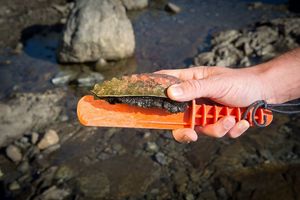Daily catch/bag and legal size limits
Pāua are a precious resource, for both their flesh and their multicoloured shells. Legal size limits are set to allow pāua to reach maturity and breed before they are harvested.
Limits
The daily catch limit and minimum size limits can vary from place to place. This is also true for how much paua you can keep in total even in your freezer at home.
There are a number of areas around the coast where taking paua is prohibited or closely restricted.
Check the fishing rules for your area
Only fishers physically gathering pāua from rocks can take their daily limit. A person cannot take a daily limit on behalf of another person, a helper, or top up the catch of someone else.
Legal sizes
Pāua are measured by the longest length in a straight line across the bottom of the shell.
Black foot and yellow foot paua have different minimum legal sizes and this can vary across the country, so be careful to check the rules before you gather.
Gatherers must measure their pāua as they take them from the rock. Carefully return undersize pāua to the rocks they were taken from as soon as possible. It is not acceptable to measure your catch at the end of your time in the water.
Restrictions on underwater breathing apparatus
You can't have an underwater breathing apparatus (UBA) while collecting pāua (or while you're in possession of pāua). This includes having a UBA in your vehicle or on your vessel.
Pāua along the earthquake affected coast line - Kaikōura to Marfells Beach
Due to the November 2016 earthquake, fishing restrictions apply to a number of shellfish and seaweed species along this section of the north-eastern coast of the South Island/Te Wai Pounamu.
Details on anouncement to re-open Kaikōura coastline to pāua fishing.
Keeping pāua sustainable
To protect the sustainability of New Zealand pāua:
- measure pāua underwater, for example with a pāua knife
- never use sharp objects when removing pāua from rocks or reefs
- return undersized pāua as you found them
- keep pāua in seawater and out of the sun
- keep within the size and catch/bag limits
- take only a few pāua from each area
- never remove or shuck pāua from its shell until you're above the high-water mark.
Pāua knife
You can use our pāua knife to remove pāua without damaging them, and to check they are the right size. Contact your local fisheries office in advance for pāua knife availability.

Video: A guide to gathering pāua (1:36)
Transcript - show/hide
[Fisheries officers Justine and Tokanui address the camera directly, between video footage described below.]
Justine: Pāua can be found along much the New Zealand coastline.
Tokanui: Pāua's been taking a hammering from poaching and incorrect handling.
Justine: To ensure pāua is around for a while make sure you understand the rules for your area.
[A man crosses a beach carrying fins, a collecting bag and an orange plastic pāua knife/ruler.]
Justine: Pāua can be taken while snorkeling or sometimes by gathering at low tide.
[He rinses a dive mask in the water with the ruler/knife on the rocks next to him. He enters the water wearing a mask and snorkel. He is seen underwater wearing the snorkel.]
Justine: If you are snorkeling for pāua, no breathing apparatus is permitted. This gives pāua stocks a chance to replenish in deeper water where they can't be reached.
Tokanui: When snorkeling it's a good idea to check the size of the pāua on the spot so it has a better chance of survival if it is below the minimum size.
[The diver measures a pāua on a rock underwater.]
Tokanui: If it looks of size, gently slide a knife between the pāua and the rock, being careful not to injure the pāua as it will often bleed to death when it's been cut.
[The diver uses the plastic knife/ruler to remove the pāua from the rock, then turns it over to measure it again on the underside.]
Tokanui: If it does work out to be too small place it back where got it and hold it there for a few seconds.
[The diver places a pāua on a rock underwater and leaves his hand on it momentarily.]
Justine: Under normal circumstances you're allowed to take 10 legal-sized pāua per day. But that doesn't mean you have to get that every time. 10 might be more than you need.
Tokanui: To shuck a pāua run your thumb between the pāua and the shell. You will feel it separate. Remove the skirt and the 2 teeth at the front of the pāua. And there you have it. Ready to tenderise.
[A diver in a boat measures the underside of a pāua. We see someone insert his thumb between the flesh of the pāua and the shell almost to the second knuckle, then begin to slide his thumb around the edge of the shell to further separate it.
Justine: By following these steps, we know that our future generations can enjoy pāua.
Get text alerts on your area. Text your region name to 9889.
[A mobile phone is shown with text on the screen:
To: 9889
Southeast
Auckland
Central
Southland
Challenger
Fiordland
Kermadec]
Report poaching
You can report poaching, suspicious, or illegal activity online:
Report illegal fishing (such as poaching)
You can also:
- call 0800 4 POACHER (0800 47 62 24), or
- email poacher@mpi.govt.nz
You can help us by providing:
- the location
- vehicle/trailer registration number
- boat name
- description of the person.
When reporting any suspected poaching, put your personal safety first. All calls and personal details are treated as confidential.
Who to contact
If you have questions about pāua rules and guidelines, email info@mpi.govt.nz








